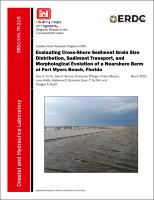Please use this identifier to cite or link to this item:
https://hdl.handle.net/11681/43780Full metadata record
| DC Field | Value | Language |
|---|---|---|
| dc.contributor.author | Zarillo, Gary Anthony, 1948- | - |
| dc.contributor.author | Ramos, Sara A. | - |
| dc.contributor.author | Watts, Irene | - |
| dc.contributor.author | Brutsche, Katherine E. | - |
| dc.contributor.author | McFall, Brian C. | - |
| dc.contributor.author | Krafft, Douglas R. | - |
| dc.contributor.author | Becker, Kristen | en_US |
| dc.contributor.author | Effinger, Kristopher | en_US |
| dc.creator | Coastal and Hydraulics Laboratory (U.S.) | - |
| dc.date.accessioned | 2022-03-29T13:08:12Z | - |
| dc.date.available | 2022-03-29T13:08:12Z | - |
| dc.date.issued | 2022-03 | - |
| dc.identifier.govdoc | ERDC/CHL TR-22-5 | - |
| dc.identifier.uri | https://hdl.handle.net/11681/43780 | - |
| dc.identifier.uri | http://dx.doi.org/10.21079/11681/43780 | - |
| dc.description | Technical Report | en_US |
| dc.description.abstract | Navigation channels are periodically dredged to maintain safe depths. Dredged sediment was historically placed in upland management areas or in offshore disposal areas. Florida state law prohibits placement of beach fill sediment that contains more than 10% by weight of silt and clay, which is typically a characteristic of dredged material. An alternative is placement in a nearshore berm. Some potential benefits of nearshore berms include wave energy dissipation, reduced cost of dredging and shore protection, and possible onshore movement of the berm material. This study considers sediment distribution, morphological evolution, sediment transport, and shoreline trends along Fort Myers Beach, Florida, related to the nearshore berm constructed in August 2016. Due to timing of the field study, this report also includes information on the influence of a major hurricane that impacted the area. The overall conclusion of this study is that the dredge-sourced sediment in the berm performed as expected. Within 2 years, the berm adjusted to the shoreface environment, maintained a large part of its original volume, and contributed to protection of the beach and shoreline. The impact of Hurricane Irma included a shift in sediment textures and a large but temporary increase in shoreface sediment volumes. | en_US |
| dc.description.sponsorship | Coastal Inlets Research Program (U.S.) | en_US |
| dc.description.tableofcontents | Abstract .................................................................................................................................... ii Figures and Tables ................................................................................................................... v Preface ..................................................................................................................................... x 1 Introduction ...................................................................................................................... 1 1.1 Background ........................................................................................................ 1 1.2 Objective ............................................................................................................ 2 1.3 Approach ............................................................................................................ 2 1.4 Report organization ........................................................................................... 2 2 Description of the Study Area and Previous Work ....................................................... 3 2.1 Site description .................................................................................................. 3 2.2 Meteorological and oceanographic setting ...................................................... 3 2.3 Geologic settings ............................................................................................... 4 2.4 Previous coastal engineering work ................................................................... 6 2.5 Nearshore berm history .................................................................................... 8 2.6 Shoreline change studies ............................................................................... 10 3 Methods .......................................................................................................................... 11 3.1 Topographic surveys ........................................................................................11 3.1.1 Topographic data collection ..................................................................................... 11 3.1.2 Topographic data processing ................................................................................... 13 3.2 Sediment data collection and analysis .......................................................... 14 3.2.1 Field data collection .................................................................................................. 14 3.2.2 Laboratory methods .................................................................................................. 15 3.2.3 Sediment size distribution ........................................................................................ 18 3.2.4 Statistical analyses ................................................................................................... 18 3.3 Shoreline change analysis ............................................................................. 20 4 Results ............................................................................................................................. 22 4.1 Sediment grain size distribution .................................................................... 22 4.2 Sediment statistic test results ....................................................................... 28 4.3 Carbonate distribution ................................................................................... 35 4.4 Suspended sediment concentrations ............................................................ 37 4.5 Summary of sediment data ........................................................................... 40 4.6 Morphological evolution ................................................................................. 42 4.6.1 Cross-shore profile analyses .................................................................................... 42 4.6.2 Topographic surface analysis ................................................................................... 45 4.7 Analyses of volume changes and local sediment budget ............................ 50 4.8 Summary of morphological evolution and sand budget .............................. 56 4.9 Shoreline changes ........................................................................................... 57 4.10 Summary of shoreline changes ................................................................ 62 5 Discussion ....................................................................................................................... 63 6 Conclusions and Recommendations ........................................................................... 68 References ............................................................................................................................. 72 Appendix: Profile Figures ..................................................................................................... 75 Unit Conversion Factors ....................................................................................................... 78 Acronyms and Abbreviations ............................................................................................... 79 Report Documentation Page | - |
| dc.format.extent | 92 pages / 12.2 MB | - |
| dc.format.medium | - | |
| dc.language.iso | en_US | en_US |
| dc.publisher | Engineer Research and Development Center (U.S.) | en_US |
| dc.relation.ispartofseries | Technical Report (Engineer Research and Development Center (U.S.)) ; no. ERDC/CHL TR-22-5 | - |
| dc.rights | Approved for Public Release; Distribution is Unlimited | - |
| dc.source | This Digital Resource was created in Microsoft Word and Adobe Acrobat | - |
| dc.subject | Beach nourishment | en_US |
| dc.subject | Coastal sediments | en_US |
| dc.subject | Dredging spoil | en_US |
| dc.subject | Fort Myers (Fla.) | en_US |
| dc.subject | Littoral drift | en_US |
| dc.subject | Sedimentation and deposition | en_US |
| dc.title | Evaluating cross-shore sediment grain size distribution, sediment transport, and morphological evolution of a nearshore berm at Fort Myers Beach, Florida | en_US |
| dc.type | Report | en_US |
| Appears in Collections: | Technical Report | |
Files in This Item:
| File | Description | Size | Format | |
|---|---|---|---|---|
| ERDC-CHL TR-22-5.pdf | 12.2 MB | Adobe PDF |  View/Open |